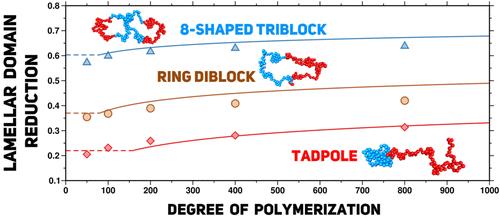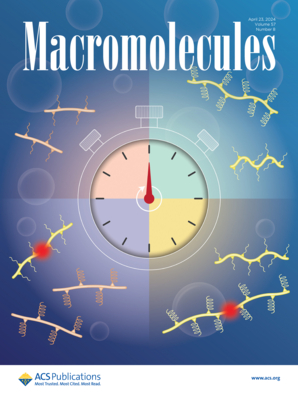Lamellar Domain Spacing of Copolymers with Nonlinear Block Architectures
IF 5.1
1区 化学
Q1 POLYMER SCIENCE
引用次数: 0
Abstract
Topological modification of block copolymer (BCP) conformations offers a promising approach for developing self-assembled periodic nanostructured materials with smaller domain sizes, which are essential for a range of technological applications. Cyclic polymers, with their inherently more compact conformations, present an effective strategy for achieving this miniaturization. In this work, through a combination of analytical theory and coarse-grained molecular dynamics simulations, we establish a relationship between different nonlinear topologies and the corresponding domain size of lamella-forming BCPs. Our investigations includes BCP architectures with one or two cyclic segments such as tadpoles, diblock and triblock 8-shaped polymers, and diblock nonconcatenated and concatenated rings. We demonstrate that the primary reduction in lamellar domain size is driven by the more compact arrangement of monomers in the cyclic architectures, with an additional contribution from the nonconcatenation of cyclic segments. This is corroborated by theoretical predictions for both domain size reduction and BCP conformations across different architectures. Moreover, consistent with theoretical expectations, the nonconcatenation of rings reduces the interpenetration of opposing brushes, thereby lowering friction between lamellae.

求助全文
约1分钟内获得全文
求助全文
来源期刊

Macromolecules
工程技术-高分子科学
CiteScore
9.30
自引率
16.40%
发文量
942
审稿时长
2 months
期刊介绍:
Macromolecules publishes original, fundamental, and impactful research on all aspects of polymer science. Topics of interest include synthesis (e.g., controlled polymerizations, polymerization catalysis, post polymerization modification, new monomer structures and polymer architectures, and polymerization mechanisms/kinetics analysis); phase behavior, thermodynamics, dynamic, and ordering/disordering phenomena (e.g., self-assembly, gelation, crystallization, solution/melt/solid-state characteristics); structure and properties (e.g., mechanical and rheological properties, surface/interfacial characteristics, electronic and transport properties); new state of the art characterization (e.g., spectroscopy, scattering, microscopy, rheology), simulation (e.g., Monte Carlo, molecular dynamics, multi-scale/coarse-grained modeling), and theoretical methods. Renewable/sustainable polymers, polymer networks, responsive polymers, electro-, magneto- and opto-active macromolecules, inorganic polymers, charge-transporting polymers (ion-containing, semiconducting, and conducting), nanostructured polymers, and polymer composites are also of interest. Typical papers published in Macromolecules showcase important and innovative concepts, experimental methods/observations, and theoretical/computational approaches that demonstrate a fundamental advance in the understanding of polymers.
 求助内容:
求助内容: 应助结果提醒方式:
应助结果提醒方式:


